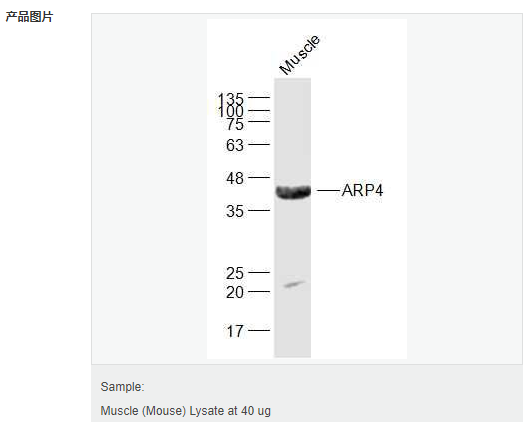

貨號(hào)
產(chǎn)品規(guī)格
售價(jià)
備注
BN41034R-100ul
100ul
¥2360.00
交叉反應(yīng):Mouse(predicted:Human,Rat,Dog,Pig,Cow,Rabbit) 推薦應(yīng)用:WB,ELISA
BN41034R-200ul
200ul
¥3490.00
交叉反應(yīng):Mouse(predicted:Human,Rat,Dog,Pig,Cow,Rabbit) 推薦應(yīng)用:WB,ELISA
產(chǎn)品描述
| 英文名稱(chēng) | Angiopoietin-like 4 |
| 中文名稱(chēng) | 肝血管生成素相關(guān)蛋白4抗體 |
| 別 名 | Angiopoietin like 4; Angiopoietin related protein 4; Angiopoietin-like protein 4; Angiopoietin-related protein 4; ANGL4_MOUSE; ANGPT L2; ANGPT L4; ANGPTL2; ANGPTL4; ARP4; Fasting induced adipose factor; FIAF; Hepatic angiopoietin related protein; Hepatic fibrinogen/angiopoietin related protein; Hepatic fibrinogen/angiopoietin-related protein; HFARP; NL2; Peroxisome proliferator-activated receptor (PPAR) gamma induced angiopoietin related protein; PGAR; pp1158; PPARG angiopoietin related protein; PSEC0166; Weakly similar to angiopoietin 1 [H.sapiens]; ANGL4_HUMAN. |
| 研究領(lǐng)域 | 腫瘤 細(xì)胞生物 免疫學(xué) 轉(zhuǎn)錄調(diào)節(jié)因子 |
| 抗體來(lái)源 | Rabbit |
| 克隆類(lèi)型 | Polyclonal |
| 交叉反應(yīng) | Mouse, (predicted: Human, Rat, Dog, Pig, Cow, Rabbit, ) |
| 產(chǎn)品應(yīng)用 | WB=1:500-2000 ELISA=1:5000-10000 not yet tested in other applications. optimal dilutions/concentrations should be determined by the end user. |
| 分 子 量 | 42kDa |
| 細(xì)胞定位 | 細(xì)胞外基質(zhì) 分泌型蛋白 |
| 性 狀 | Liquid |
| 濃 度 | 1mg/ml |
| 免 疫 原 | KLH conjugated synthetic peptide derived from mouse ARP4:331-410/410 |
| 亞 型 | IgG |
| 純化方法 | affinity purified by Protein A |
| 儲(chǔ) 存 液 | 0.01M TBS(pH7.4) with 1% BSA, 0.03% Proclin300 and 50% Glycerol. |
| 保存條件 | Shipped at 4℃. Store at -20 °C for one year. Avoid repeated freeze/thaw cycles. |
| PubMed | PubMed |
| 產(chǎn)品介紹 | This gene encodes a glycosylated, secreted protein containing a C-terminal fibrinogen domain. The encoded protein is induced by peroxisome proliferation activators and functions as a serum hormone that regulates glucose homeostasis, lipid metabolism, and insulin sensitivity. This protein can also act as an apoptosis survival factor for vascular endothelial cells and can prevent metastasis by inhibiting vascular growth and tumor cell invasion. The C-terminal domain may be proteolytically-cleaved from the full-length secreted protein. Decreased expression of this gene has been associated with type 2 diabetes. Alternative splicing results in multiple transcript variants. This gene was previously referred to as ANGPTL2 but has been renamed ANGPTL4. [provided by RefSeq, Sep 2013] Function: Protein with hypoxia-induced expression in endothelial cells. May act as a regulator of angiogenesis and modulate tumorgenesis. Inhibits proliferation, migration, and tubule formation of endothelial cells and reduces vascular leakage. May exert a protective function on endothelial cells through an endocrine action. It is directly involved in regulating glucose homeostasis, lipid metabolism, and insulin sensitivity. In response to hypoxia, the unprocessed form of the protein accumulates in the subendothelial extracellular matrix (ECM). The matrix-associated and immobilized unprocessed form limits the formation of actin stress fibers and focal contacts in the adhering endothelial cells and inhibits their adhesion. It also decreases motility of endothelial cells and inhibits the sprouting and tube formation. Subunit: Homooligomer. The homooligomer undergoes proteolytic processing to release its carboxyl fibrinogen-like domain, which circulates as a monomer. The homooligomer unprocessed form is able to interact with the extracellular matrix. Subcellular Location: Secreted. Secreted, extracellular space, extracellular matrix. Tissue Specificity: Expressed at high levels in the placenta, heart, liver, muscle, pancreas and lung but expressed poorly in the brain and kidney. Post-translational modifications: N-glycosylated. Similarity: Contains 1 fibrinogen C-terminal domain. SWISS: Q9Z1P8 Gene ID: 57875 Database links: Entrez Gene: 51129 Human Omim: 605910 Human SwissProt: Q9BY76 Human Unigene: 9613 Human Important Note: This product as supplied is intended for research use only, not for use in human, therapeutic or diagnostic applications. |
